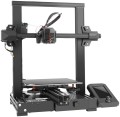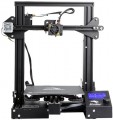Filament material
Compatible software
Software for building models which the printer is optimally compatible with. The software used for 3D printing includes both CAD (automatic design systems for creating models) and slicers (software that break a three-dimensional model into separate layers, preparing it for printing). Therefore, this paragraph often indicates a whole list of software products.
Note that the degree of optimization in this case may be different: some models are compatible only with the claimed programs, but many printers are able to work with third-party CAD systems. However, it is best to choose software directly claimed by the manufacturer: this will maximize the capabilities of the printer and minimize the chance of failures and “inconsistencies” during operation.
Min layer thickness
The smallest thickness of a single layer of material that can be applied with a printer.
In photopolymer devices of SLA and DLP formats (see "Print Technology") the meaning of this parameter is simple: it is the smallest height of a one pass cycle of the working platform. The smaller this height, the better detailing can be achieved on the device; however, in such models, this height is usually small — most often
less than 50 µm. But in devices based on FDM/FFF and similar technologies using nozzles, there are also higher rates —
51 – 100 µm and even
more. Here it is worth noting the fact that a small minimum layer thickness allows efficient use of small nozzles and achieves better detail. On the other hand, increasing detailing reduces productivity, and to compensate this fact, it is necessary to increase the print speed by increasing power (both heating and blowing), which, in turn, affects the cost. Therefore, choosing one should proceed from real needs: for objects with relatively low detail, there is no need to look for a printer with a small layer thickness.
It is worth noting that in FDM/FFF printers, the optimal layer thickness depends on the nozzle diameter (see below) and the specifics of printing — for example, for a “in one line” perimeter without filling, you can use the minimum layer thickness, while for filling it is not recommended. Det
...ailed recommendations on the optimal layer thickness for different situations can be found in special guides.Print speed
The print speed provided by an FDM/FFF type 3D printer (see "Print Technology").
The print speed in this case is the maximum amount of material that can pass through a regular nozzle per second. The higher this value (
150 mm/s,
180 mm/s ,
200 mm/s and
above), the faster the printer is able to cope with a particular task. Of course, the actual production time will depend on the configuration of the printing model and the print settings, but other things being equal, a printer with a higher speed will operate faster. On the other hand, an increase in speed requires an increase in heating power (because the extruder has time to melt the required volume of material), blowing power (otherwise the plastic will not have time to solidify normally), as well as stricter control of the movement of the extruder (to compensate for inertia from fast movements). So, generally, this spec strongly depends on the price category and specialization of the device, and it’s worth looking specifically for a “fast” model in cases where the speed of production is critical. Otherwise, a
100 mm/s model or
120 mm/s is sufficient, or even less.
Heating bed temperature
Maximum heating temperature in 3D printers with heated bed (for more details, see the relevant paragraph). The higher the limit, the more varieties of plastic can be used for printing. So, models with heating up to 100 °C are suitable for 3D printing with PLA plastic, with a bed temperature of 100 to 120 °C — for working with ABS plastic and nylon, high-temperature ones — allow the use of polycarbonate and refractory varieties of plastic.
Extruder (nozzle) temperature
The heating temperature provided by the extruder in an FDM/FFF or PJP printer (see Printing Technology) .
Compatibility with this or that printed material directly depends on this parameter. For example, for PLA plastic, temperature range 180 – 230 °C is required, for ABS it will require 220 – 250 °C, and for polycarbonate — at least 270 °C. The temperature definitely should not be too low — otherwise the material simply cannot melt normally. But the margin in most cases is quite acceptable — for example, many PLA-compatible models operate at temperatures of about 250 °C, or even 280 °C.
Thus, a higher operating temperature enhances the printer's capabilities and its compatibility with various types of thermoplastics. On the other hand, the more the material is heated, the worse it cools down; to ensure sufficient solidification efficiency, one must either reduce the printing speed (which increases the time required) or increase the blowing intensity (which affects the cost). Well, anyway, while choosing, you should focus primarily on filaments, which compatibility is directly indicated in the specs.
Extruder type
Extruders in 3D printers are responsible for feeding plastic material and creating three-dimensional objects from it. In fact, the extruder is a print head that creates new objects. There are two main types of extruders:
— Direct. Direct type of extruder with the feeding mechanism placed directly on the movable carriage. This provides a number of advantages, in particular, the ability to print with flexible plastics even at high speeds, insignificant printing errors due to the minimum feeding distance, and quick and convenient replacement of printing materials. At the same time, Direct type extruders have large dimensions and weight, which entails an increase in inertia - if errors are detected, such a carriage cannot be stopped instantly, and its weight must be taken into account when programming the print.
— Bowden. In this version, the extruder is separated from the printing mechanism, and the filament is supplied to the hotend (heating part) through a special tube. This feed allows you to lighten the weight of the carriage by moving the engine to the frame. The dimensions of the print head are also reduced. Bowden-type extruders limit the handling of flexible materials, increase the tolerance of the printing rod, and make changing materials more difficult. However, overall printing speed increases.
Stepper Motor Driver
Drivers are small chips that control the drives in 3D printers. Essentially, they control the flow of current to the stepper motor. Drivers from Trinamic Motion Control are widely used. Thus, the TMC2208 and TMC2209, as well as their improved modification TMC2225, are rightfully considered very quiet options. These drivers support step division up to 1:256 and can function either independently with manual changes or in UART mode, in which the motor current is adjusted via firmware.
LCD display
The printer has its own screen. The specific functionality of such a screen can be different - from the simplest indicator for several characters and service symbols to a full-fledged color matrix capable of displaying inscriptions, drawings, etc.; These nuances should be clarified separately. However, in any case, this feature provides additional ease of management: various service information can be displayed on the screen to help the user set up printing parameters and control the process.
We would like to emphasize that touch displays are not included in this category; they are indicated as a separate function. But the screen size directly affects the comfort when working with the device.
There are also models with a touch screen, similar to those used in smartphones and tablets. Such a display is a full-fledged control tool, and it is more convenient and functional than more traditional options such as keypads: you can display a wide variety of control elements (buttons, sliders, lists, etc.) on the screen, selecting the optimal set of these elements for your needs. specific situation. In addition, the screen itself usually has a color matrix with a fairly high resolution, which makes it possible to display a wide variety of service data - even drawings and diagrams. Thanks to all this, most printer control functions can be performed through such a display; some models with such equipment are able to work even without connecting to a computer. The disad...vantages of touch displays include their higher cost than conventional ones, despite the fact that control via a computer is usually still more practical and visual. So this function is relatively rare these days.

